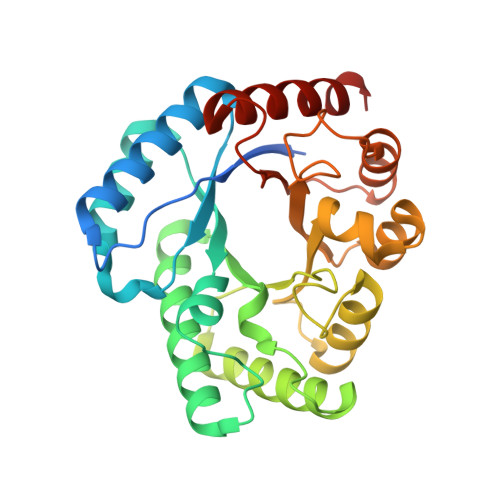TM0416, a Hyperthermophilic Promiscuous Nonphosphorylated Sugar Isomerase, Catalyzes Various C5and C6Epimerization Reactions
Shin, S.M., Cao, T.P., Choi, J.M., Kim, S.B., Lee, S.J., Lee, S.H., Lee, D.W.(2017) Appl Environ Microbiol 83
- PubMed: 28258150
- DOI: https://doi.org/10.1128/AEM.03291-16
- Primary Citation of Related Structures:
5B7Y, 5B7Z, 5B80, 5H1W, 5H6H - PubMed Abstract:
There is currently little information on nonphosphorylated sugar epimerases, which are of potential interest for producing rare sugars. We found a gene (the TM0416 gene) encoding a putative d-tagatose-3-epimerase-related protein from the hyperthermophilic bacterium Thermotoga maritima We overexpressed the TM0416 gene in Escherichia coli and purified the resulting recombinant protein for detailed characterization. Amino acid sequence alignment and a structural similarity search revealed that TM0416 is a putative nonphosphorylated sugar epimerase. The recombinant enzyme exhibited maximal C-3 epimerization of l-ribulose to l-xylulose at ∼80°C and pH 7 in the presence of 1 mM Mn 2+ In addition, this enzyme showed unusually high activity for the epimerization of d-tagatose to d-sorbose, with a conversion yield of 20% after 6 h at 80°C. Remarkably, the enzyme catalyzed the isomerization of d-erythrose or d-threose to d-erythrulose significantly, with conversion yields of 71% and 54.5%, respectively, after 6 h at 80°C at pH 7. To further investigate the substrate specificity of TM0416, we determined its crystal structures in complex with divalent metal ions and l-erythrulose at resolutions of 1.5 and 1.6 Å. Detailed inspection of the structural features and biochemical data clearly demonstrated that this metalloenzyme, with a freely accessible substrate-binding site and neighboring hydrophobic residues, exhibits different and promiscuous substrate preferences, compared with its mesophilic counterparts. Therefore, this study suggests that TM0416 can be functionally classified as a novel type of l-ribulose 3-epimerase (R3E) with d-erythrose isomerase activity. IMPORTANCE Rare sugars, which occur naturally in small amounts, have attracted considerable attention in the food and drug industries. However, there is little information on nonphosphorylated sugar epimerases, which might potentially be applied for the production of rare sugars. This study describes the characterization and functional annotation of a putative nonphosphorylated sugar 3-epimerase from a hyperthermophilic bacterium. Furthermore, we determined its crystal structures in complex with divalent metal ions and l-erythrulose, highlighting its metal-dependent, bifunctional, sugar-isomerizing activity. This hyperthermophilic R3E exhibited d-erythrose/d-threose isomerase activity, with structural features near the substrate-binding site distinct from those of its mesophilic counterparts. Moreover, this metalloenzyme showed unusually high activity for the epimerization of d-tagatose to d-sorbose at 70°C. Therefore, TM0416 can be functionally classified as a novel type of promiscuous R3E with a potential for the production of rare sugars for the food and pharmaceutical industries.
Organizational Affiliation:
School of Applied Biosciences, Kyungpook National University, Daegu, South Korea.

















